Development and Calibration of a New Dripper-Based Rainfall Simulator for Large-Scale Sediment Wash-Off Studies
Abstract
:1. Introduction
2. Materials and Methods
2.1. Rainfall Simulator Description
2.2. Calibration Procedure
2.3. Rain Properties of Calibrated Rainfall Simulator
3. Results
3.1. Local Natural Rain Properties Recorded
3.2. Calibration Results
3.3. Measured Rain Properties of the Developed Rainfall Simulator
3.4. Simulated and Natural Rain Comparison
4. Discussion
5. Conclusions
- Modifying the density of drippers and their flow rate makes possible the precise generation of a wide range of rainfalls with different intensities, maintaining suitable uniformities and raindrop diameter distributions. This design has been presented as a suitable solution for simulating low rain intensities, which is a clear improvement on nozzles-based simulators that have to resort to intermittent rains.
- Very good spatial uniformity of rain intensities was obtained covering an area of 36 m2, both for high-resolution measurements during calibration (10 cm resolution) and for large-scale measurements during rain characterization of the final solution (resolution of 50 cm). The Christiansen’s UC obtained of 81%, 89% and 91% for the rain intensities of 30, 50 and 80 mm/h, respectively, showed almost uniform rainfalls, which confirms a good transferability of the experimental results that will be obtained when using the simulator.
- This rainfall simulator design allowed for controlling rain properties from the calibration of the mesh typology, mesh size, and mesh-drippers distance. The calibration performed in this study has achieve a very accurate representation of raindrop size distribution using local natural rain measurements as a reference, and maintaining good rain uniformity. In this study, the simulator was installed as high as possible, at 2.6 m, achieving suitable raindrop impact velocities of around 87.5% of their terminal velocities for the mean raindrop diameter and 75% for larger raindrops of up to 3 mm. This impact velocity of large raindrops could be further improved by increasing the simulator height to roughly 4.5 m.
Author Contributions
Funding
Conflicts of Interest
References
- United Nations, Department of Economic and Social Affairs. Population Division the World’s Cities in 2018—Data Booklet (ST/ESA/SER.A/417); United Nations: New York, NY, USA, 2018. [Google Scholar]
- Akan, A.O.; Houghtalen, R.J. Urban Hydrology, Hydraulics, and Stormwater Quality: Engineering Applications and Computer Modelling; John Wiley & Sons: Hoboken, NJ, USA, 2003. [Google Scholar]
- Anta, J.; Peña, E.; Suárez, J.; Cagiao, J. A BMP selection process based on the granulometry of runoff solids in a separate urban catchment. Water SA 2006, 32, 419–428. [Google Scholar] [CrossRef] [Green Version]
- Zafra, C.; Temprano, J.; Suárez, J. A simplified method for determining potential heavy metal loads washed off by stormwater runoff from road-deposited sediments. Sci. Total Environ. 2017, 601, 260–270. [Google Scholar] [CrossRef] [PubMed] [Green Version]
- Egodawatta, P.; Thomas, E.; Goonetilleke, A. Mathematical interpretation of pollutant wash-off from urban road surfaces using simulated rainfall. Water Res. 2007, 41, 3025–3031. [Google Scholar] [CrossRef] [PubMed] [Green Version]
- Butler, D.; Digman, C.J.; Makropoulos, C.; Davies, J.W. Urban Drainage, 4th ed.; CRC Press: Boca Raton, FL, USA, 2018. [Google Scholar]
- Wijesiri, B.; Egodawatta, P.; McGee, J.; Goonetilleke, A. Incorporating process variability into stormwater quality modelling. Sci. Total Environ. 2015, 533, 454–461. [Google Scholar] [CrossRef] [Green Version]
- Schellart, A.N.A.; Tait, S.J.; Ashley, R.M. Towards quantification of uncertainty in predicting water quality failures in integrated catchment model studies. Water Res. 2010, 44, 3893–3904. [Google Scholar] [CrossRef]
- Gorgoglione, A.; Bombardelli, F.A.; Pitton, B.J.; Oki, L.R.; Haver, D.L.; Young, T.M. Uncertainty in the parameterization of sediment build-up and wash-off processes in the simulation of sediment transport in urban areas. Environ. Model. Softw. 2019, 111, 170–181. [Google Scholar] [CrossRef]
- Sartor, J.D.; Boyd, G.B. Water Pollution Aspects of Street Surface Contaminants. United States Environmental Protection Agency, Washington, DC, EPA-R2-72-081; Environmental Protection Agency: Washington, DC, USA, 1972.
- Al Ali, S.; Bonhomme, C.; Dubois, P.; Chebbo, G. Investigation of the wash-off process using an innovative portable rainfall simulator allowing continuous monitoring of flow and turbidity at the urban surface outlet. Sci. Total Environ. 2017, 609, 17–26. [Google Scholar] [CrossRef]
- Muthusamy, M.; Tait, S.J.; Schellart, A.N.A.; Beg, M.N.A.; Carvalho, F.R.; de Lima, J.L.M.P. Improving understanding of the underlying physical process of sediment wash-off from urban road surfaces. J. Hydrol. 2018, 557, 426–433. [Google Scholar] [CrossRef]
- Mamoon, A.A.; Jahan, S.; He, X.; Joergensen, N.E.; Rahman, A. First flush analysis using a rainfall simulator on a micro catchment in an arid climate. Sci. Total Environ. 2019, 693, 133552. [Google Scholar] [CrossRef]
- Grismer, M.E. Rainfall Simulation Studies—A Review of Designs, Performance and Erosion Measurement Variability. 2011. Available online: http://ucanr.org/sites/californiaagriculture/files/145682.pdf (accessed on 3 January 2020).
- Kathiravelu, G.; Lucke, T.; Nichols, P. Designing the Perfect Rainfall Simulator for Urban Stormwater Studies: An Impossible Dream? In Proceedings of the 13th International Conference on Urban Drainage, Sarawak, Malaysia, 7–12 September 2014; pp. 1–9. [Google Scholar]
- Isidoro, J.M.G.P.; de Lima, J.L.M.P.; Leandro, J. Influence of wind-driven rain on the rainfall-runoff process for urban areas: Scale model of high-rise buildings. Urban Water J. 2012, 9, 199–210. [Google Scholar] [CrossRef]
- Loch, R.J.; Robotham, B.G.; Zeller, L.; Masterman, N.; Orange, D.N.; Bridge, B.J.; Sheridan, G.; Bourke, J.J. A multi-purpose rainfall simulator for field infiltration and erosion studies. Soil Res. 2001, 39, 599–610. [Google Scholar] [CrossRef]
- Paige, G.B.; Stone, J.J.; Smith, J.R.; Kennedy, J.R. The Walnut Gulch rainfall simulator: A computer-controlled variable intensity rainfall simulator. Appl. Eng. Agric. 2004, 20, 25–31. [Google Scholar] [CrossRef]
- Herngren, L.; Goonetilleke, A.; Sukpum, R.; Silva, D.Y. de Rainfall Simulation as a Tool for Urban Water Quality Research. Environ. Eng. Sci. 2005, 22, 378–383. [Google Scholar] [CrossRef]
- Aksoy, H.; Unal, N.E.; Cokgor, S.; Gedikli, A.; Yoon, J.; Koca, K.; Inci, S.B.; Eris, E. A rainfall simulator for laboratory-scale assessment of rainfall-runoff-sediment transport processes over a two-dimensional flume. CATENA 2012, 98, 63–72. [Google Scholar] [CrossRef]
- Júnior, S.S.; Siqueira, E.Q. Development and calibration of a rainfall simulator for urban hydrology research. In Proceedings of the 12th International Conference on Urban Drainage, Porto Alegre, Brazil, 11–16 September 2011; pp. 11–16. [Google Scholar]
- Armstrong, A.; Quinton, J.N. Pumped rainfall simulators: The impact of rain pulses on sediment concentration and size. Earth Surf. Process. Landf. 2009, 34, 1310–1314. [Google Scholar] [CrossRef]
- Vaze, J.; Chiew, F.H. Study of pollutant washoff from small impervious experimental plots. Water Resour. Res. 2003, 39, 6. [Google Scholar] [CrossRef]
- Lassu, T.; Seeger, M.; Peters, P.; Keesstra, S.D. The Wageningen rainfall simulator: Set-up and calibration of an indoor nozzle-type rainfall simulator for soil erosion studies. Land Degrad. Dev. 2015, 26, 604–612. [Google Scholar] [CrossRef]
- Naves, J.; Jikia, Z.; Anta, J.; Puertas, J.; Suárez, J.; Regueiro-Picallo, M. Experimental study of pollutant washoff on a full-scale street section physical model. Water Sci. Technol. 2017, 76, 2821–2829. [Google Scholar] [CrossRef]
- Roth, C.H.; Meyer, B.; Frede, H.G. A portable rainfall simulator for studying factors affecting runoff, infiltration and soil loss. CATENA 1985, 12, 79–85. [Google Scholar] [CrossRef]
- Battany, M.C.; Grismer, M.E. Development of a portable field rainfall simulator foruse in hillside vineyard runoff and erosion studies. Hydrol. Process. 2000, 14, 1119–1129. [Google Scholar] [CrossRef]
- Clarke, M.A.; Walsh, R.P.D. A portable rainfall simulator for field assessment of splash and slopewash in remote locations. Earth Surf. Process. Landf. 2007, 32, 2052–2069. [Google Scholar] [CrossRef]
- Abd Elbasit, M.A.; Yasuda, H.; Salmi, A.; Anyoji, H. Characterization of rainfall generated by dripper-type rainfall simulator using piezoelectric transducers and its impact on splash soil erosion. Earth Surf. Process. Landf. 2010, 35, 466–475. [Google Scholar] [CrossRef]
- Christiansen, J.E. Irrigation by Sprinkling, No. 04; USDA, REPORT 1532; Agricultural Experiment Station, University of California: Berkeley, CA, USA, 1942. [Google Scholar]
- Tokay, A.; Wolff, D.B.; Petersen, W.A. Evaluation of the New Version of the Laser-Optical Disdrometer, OTT Parsivel2. J. Atmos. Ocean Technol. 2014, 31, 1276–1288. [Google Scholar] [CrossRef]
- Coutinho, M.A.; Tomás, P.P. Characterization of raindrop size distributions at the Vale Formoso Experimental Erosion Center. CATENA 1995, 25, 187–197. [Google Scholar] [CrossRef]
- Friedich, K.; Gochis, D.; Kucera, P.A.; Ikeda, K.; Sun, J. Raindrop Size Distribution and Rain Characteristics during the 2013 Great Colorado Flood. J. Hydrometeorol. 2016, 17, 53–72. [Google Scholar] [CrossRef]
- Tokay, A.; D’Adderio, L.P.; Porcù, F.; Wolff, D.B.; Petersen, W.A. A Field Study of Footprint-Scale Variability of Raindrop Size Distribution. J. Hydrometeorol. 2017, 18, 3165–3179. [Google Scholar] [CrossRef]
- Chen, B.; Hu, Z.; Liu, L.; Zhang, G. Raindrop Size Distribution Measurements at 4,500 m on the Tibetan Plateau During TIPEX-III. J. Geophys. Res. Atmos. 2017, 122, 11,092–11,106. [Google Scholar] [CrossRef]
- Tokay, A.; D’Adderio, L.P.; Wolff, D.B.; Petersen, W.A. Development and Evaluation of the Raindrop Size Distribution Parameters for the NASA Global Precipitation Measurement Mission Ground Validation Program. J. Atmos. Ocean. Technol. 2019. [Google Scholar] [CrossRef]
- Gunn, R.; Kinzer, G.D. The terminal velocity of fall for water droplets in stagmant air. J. Meteorol. 1949, 6, 243–248. [Google Scholar] [CrossRef] [Green Version]
- Tokay, A.; Bashor, P.G.; Habib, E.; Kasparis, T. Raindrop size distribution measurements in tropical cyclones. Mon. Weather Rev. 2008, 136, 1669–1685. [Google Scholar] [CrossRef] [Green Version]
- Laws, J.O. Measurements of the fall-velocity of water -drops and raindrops. Trans. Am. Geophys. Union 1941, 22, 709–721. [Google Scholar] [CrossRef]
- Nielsen, K.T.; Moldrup, P.; Thorndahl, S.; Nielsen, J.E.; Duus, L.B.; Rasmussen, S.H.; Uggerby, M.; Rasmussen, M.R. Automated rainfall simulator for variable rainfall on urban green areas. Hydrol. Process. 2019, 33, 3364–3377. [Google Scholar] [CrossRef] [Green Version]
- Iserloh, T.; Fister, W.; Seeger, M.; Willger, H.; Ries, J.B. A small portable rainfall simulator for reproducible experiments on soil erosion. Soil Tillage Res. 2012, 124, 131–137. [Google Scholar] [CrossRef]
- Naves, J.; Anta, J.; Suárez, J.; Puertas, J. Hydraulic, wash-off and sediment transport experiments in a full-scale urban drainage physical model. Sci. Data 2020, in press. [Google Scholar]
- Naves, J.; Anta, J.; Suárez, J.; Puertas, J. [Dataset] WASHTREET Hydraulic, wash-off and sediment transport experimental data in an urban drainage physical model. Zenodo 2019. [Google Scholar] [CrossRef]
- Naves, J.; Anta, J.; Puertas, J.; Regueiro-Picallo, M.; Suárez, J. Using a 2D shallow water model to assess Large-Scale Particle Image Velocimetry (LSPIV) and Structure from Motion (SfM) techniques in a street-scale urban drainage physical model. J. Hydrol. 2019, 575, 54–65. [Google Scholar] [CrossRef]
- Naves, J.; Rieckermann, J.; Cea, L.; Puertas, J.; Anta, J. Global and local sensitivity analysis to improve the understanding of physically-based urban wash-off models from high-resolution laboratory experiments. Sci. Total Environ. 2020, 709, 136152. [Google Scholar] [CrossRef]
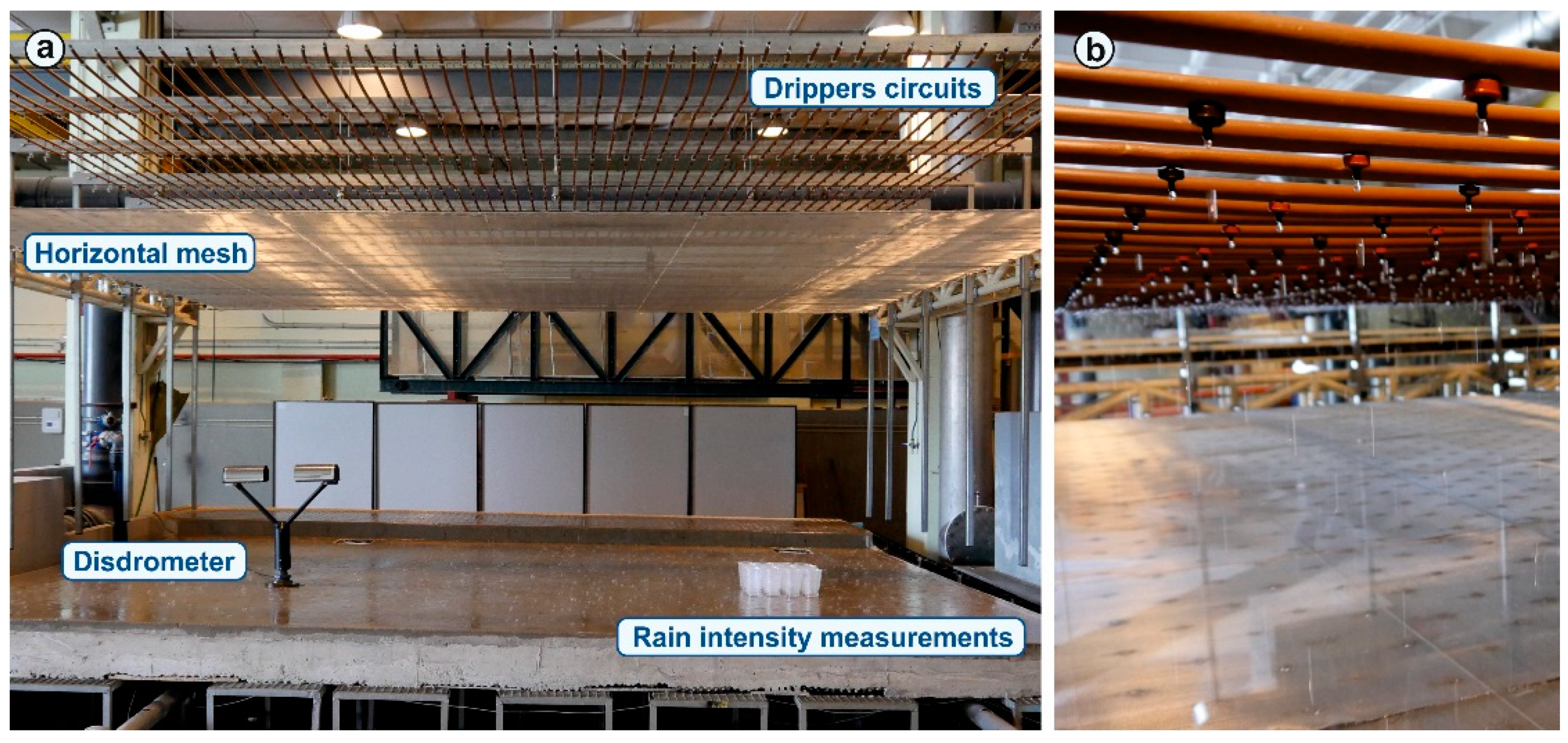
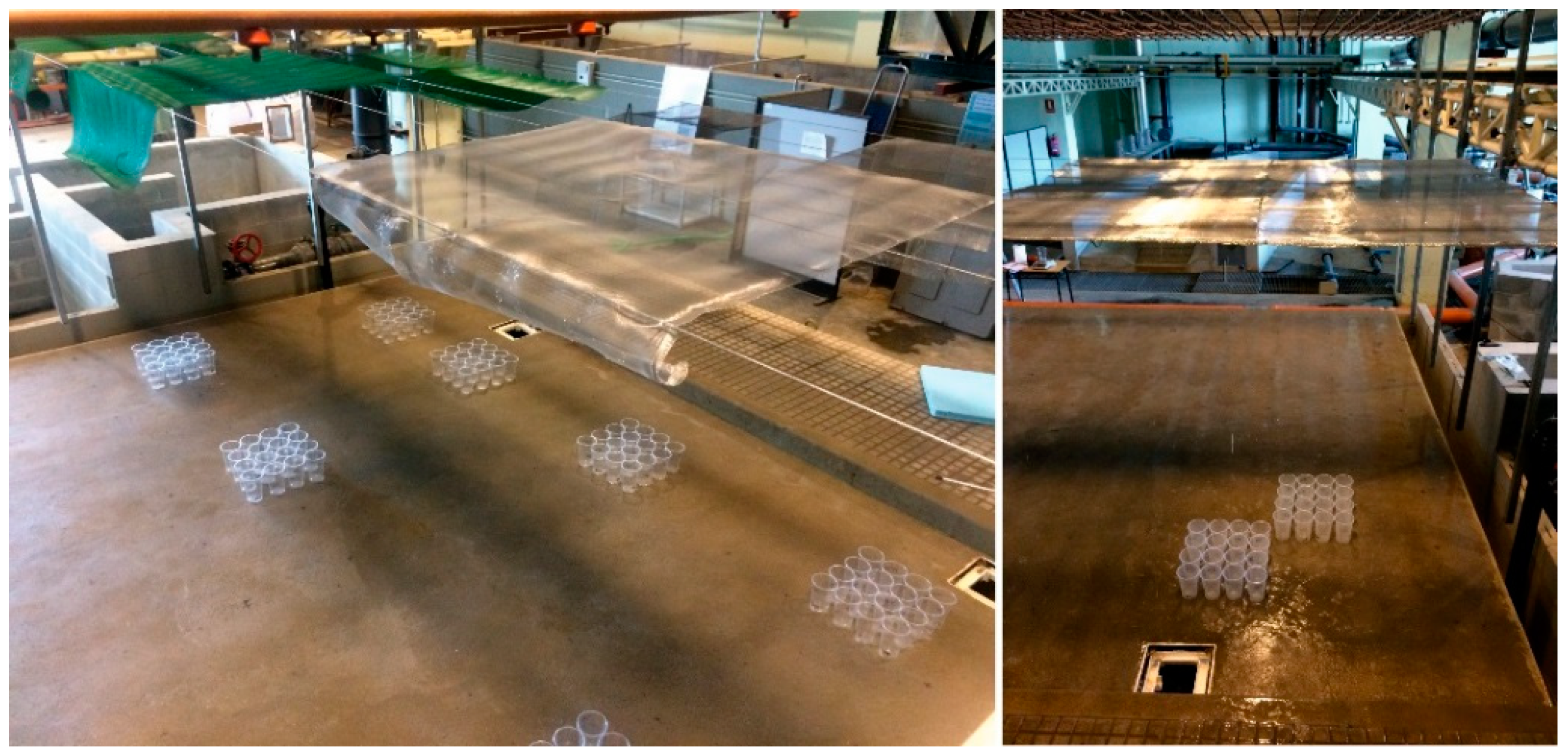
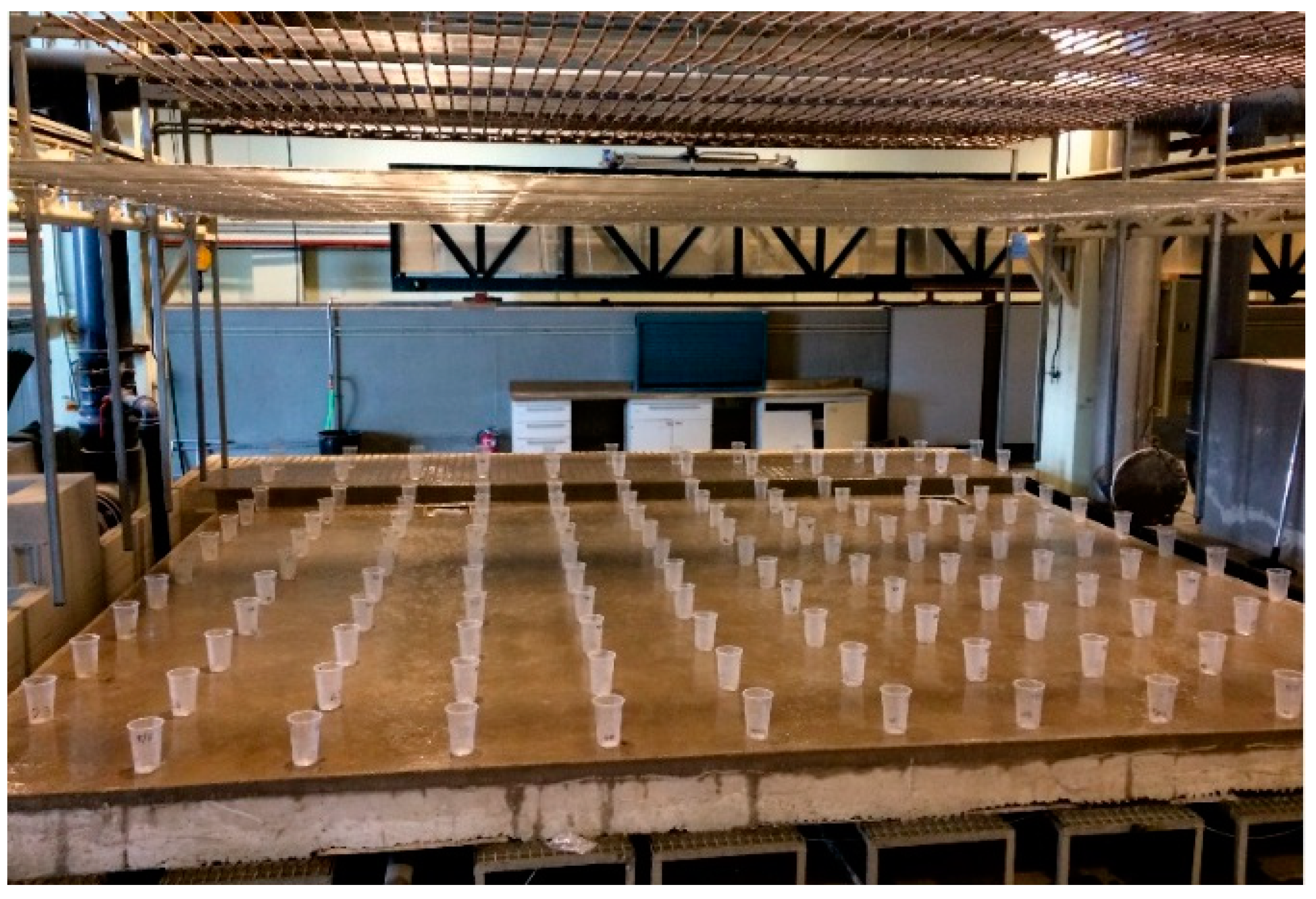

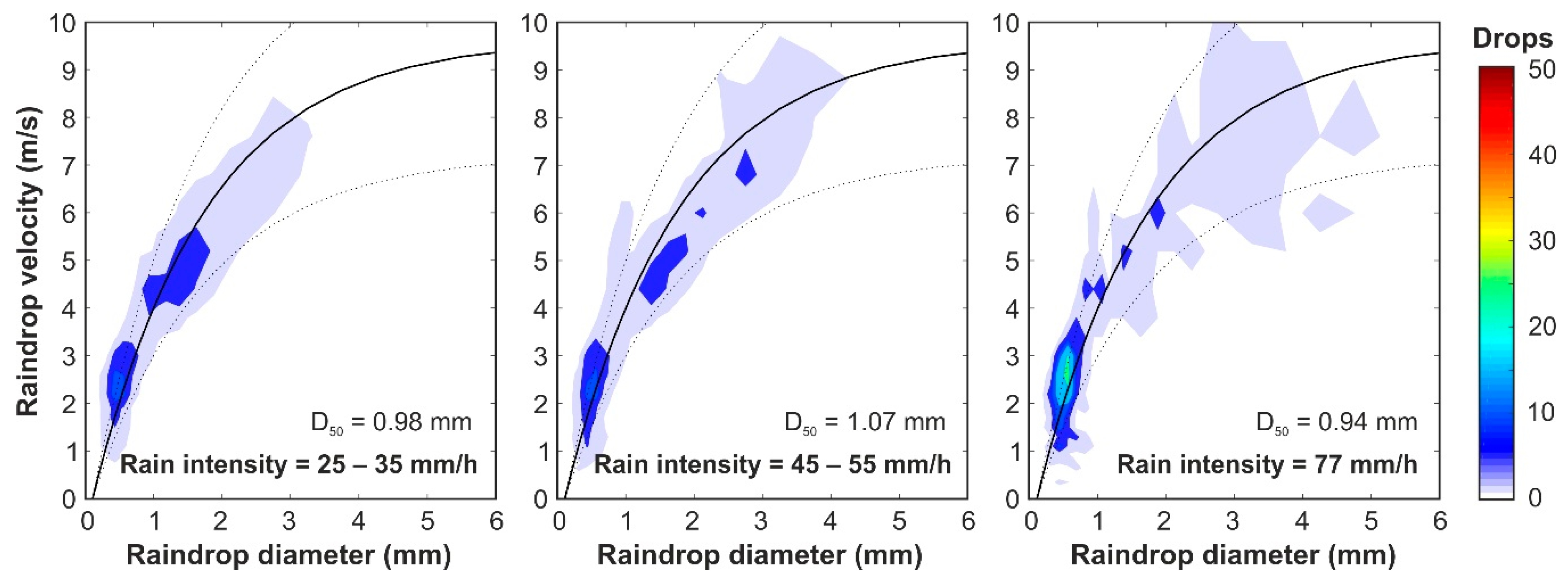

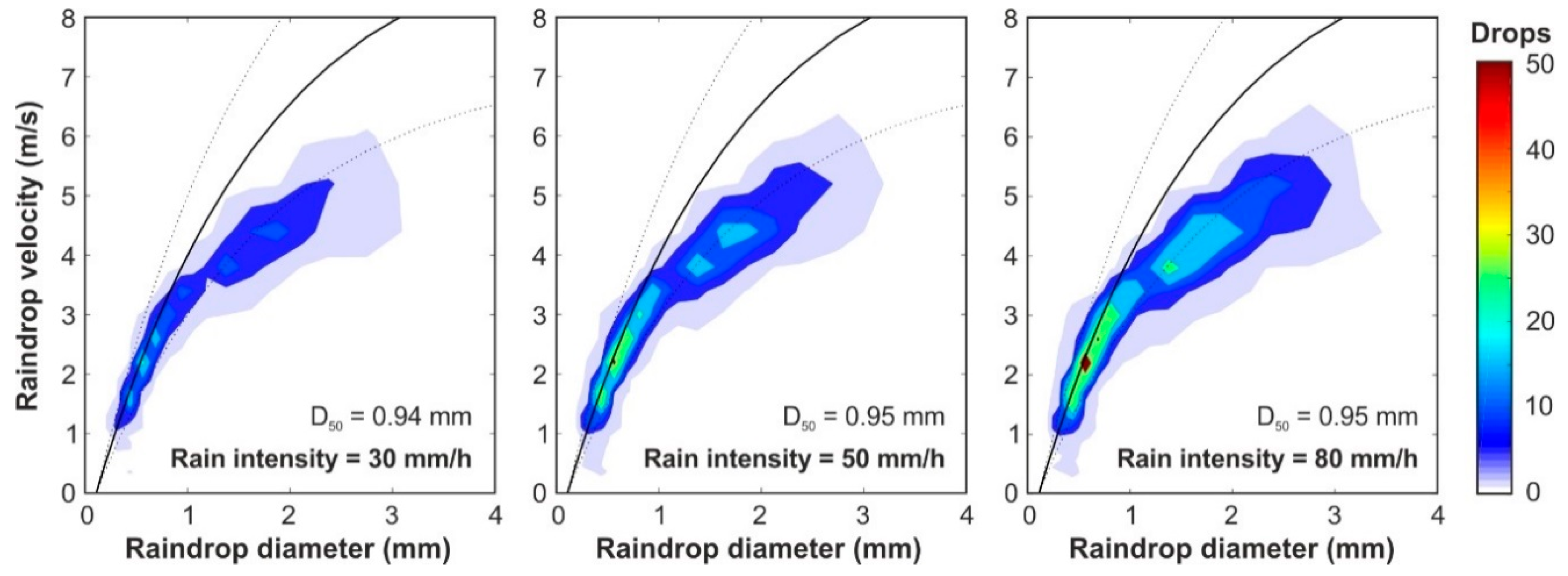
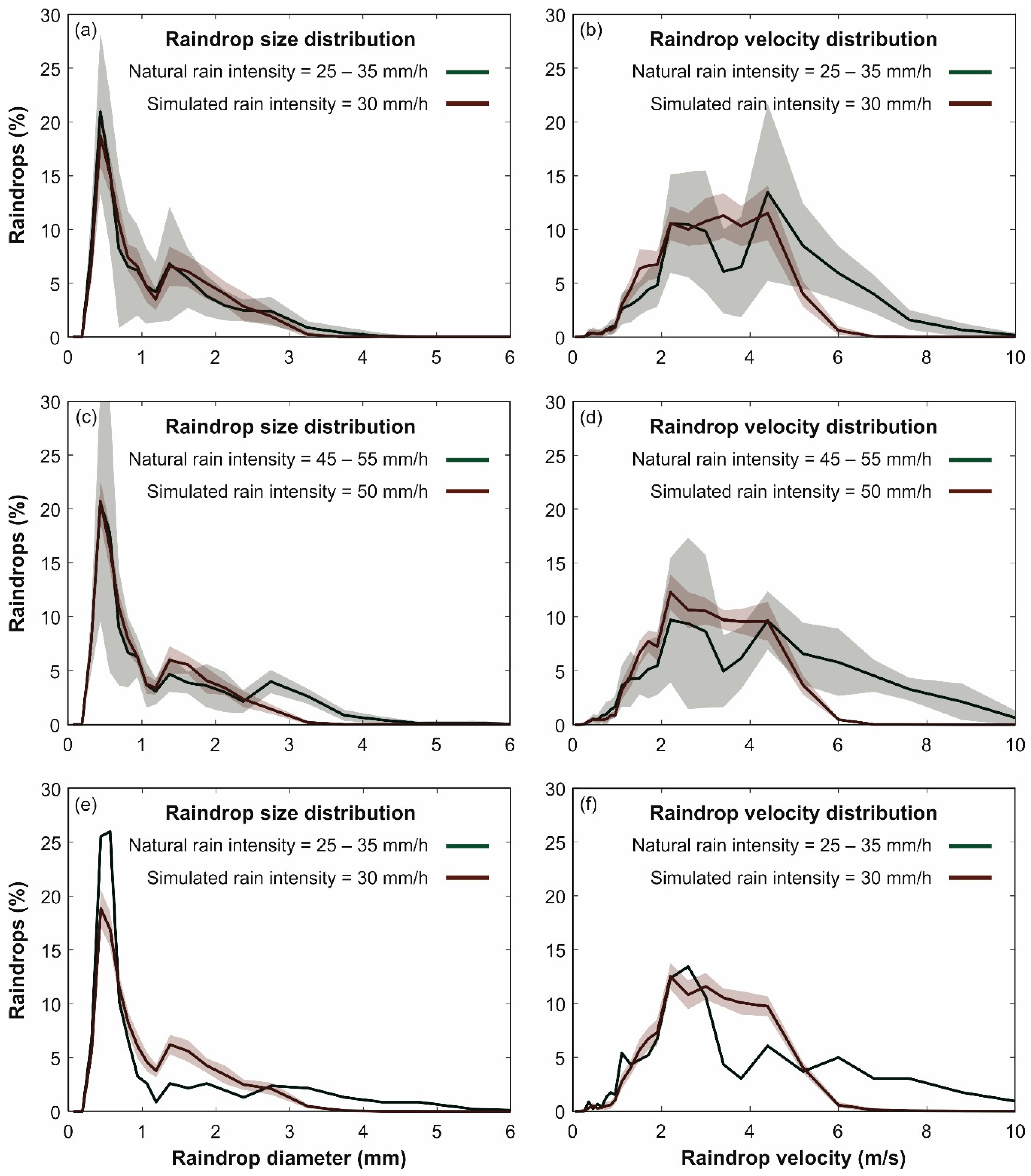
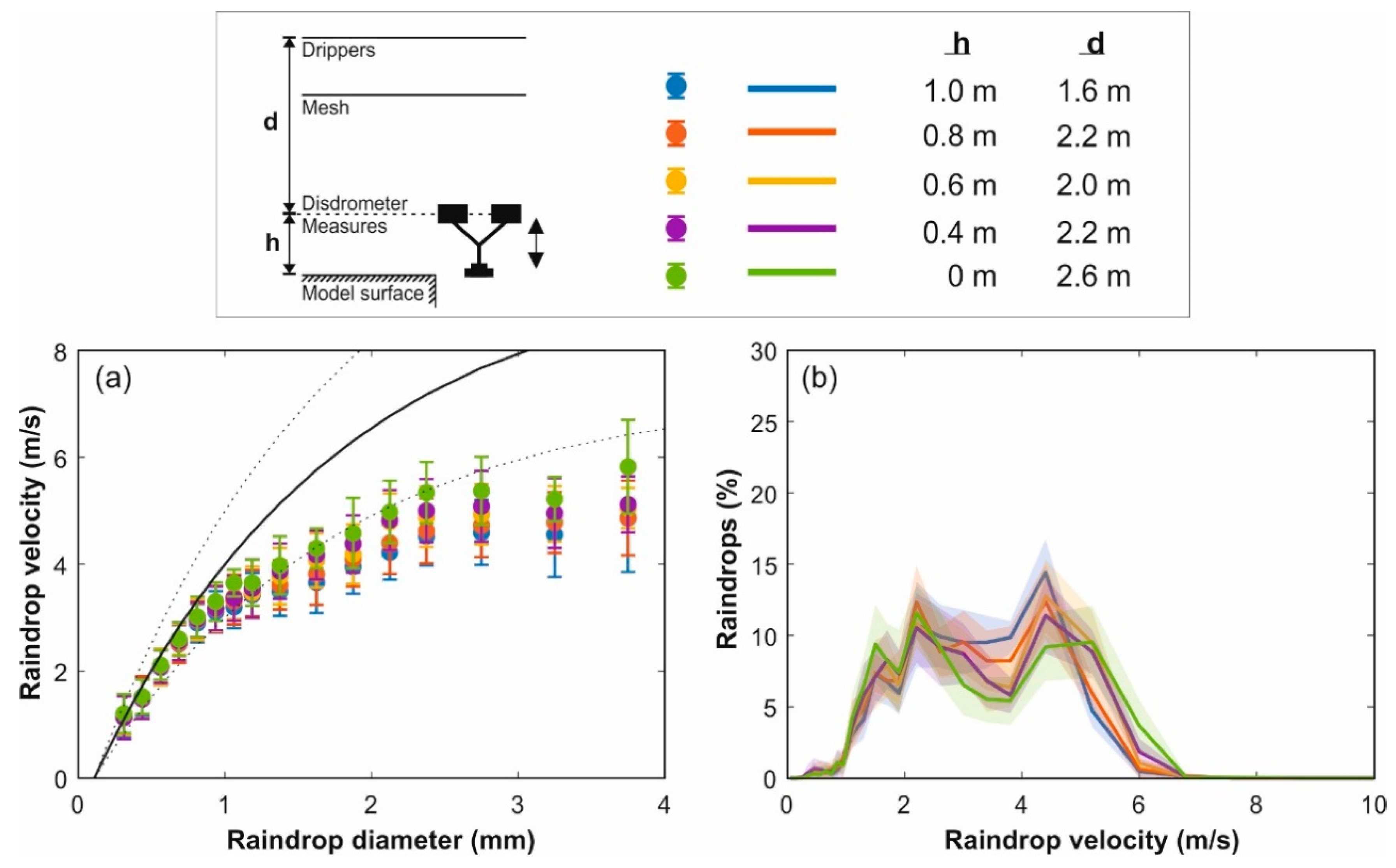
| Mesh Materials | Mesh Size (mm) | Dripper-Mesh Distance (m) | Rain Intensity Tested (mm/h) |
|---|---|---|---|
| Plastic and metal | 1–4.5 | 0.45–0.70 | 30–80 |
| #Test | Mesh Material | Mesh Size (mm) | Dripper-Mesh Distance (m) | Rain Intensity Tested (mm/h) | Mean Rain Intensity Measured (mm/h) | Uniformity Coefficient (%) | Mean Diameter (mm) | Mean Velocity (m/s) |
|---|---|---|---|---|---|---|---|---|
| 1 | Plastic | 4.5 | 0.45 | 30 | 29.9 | 62.9 | 0.89 | 2.71 |
| 2 | Plastic | 4.5 | 0.70 | 30 | 28.6 | 67.3 | 0.79 | 2.5 |
| 3 | Plastic | 2 | 0.70 | 30 | 23 | 83.4 | 0.83 | 2.77 |
| 4 | Plastic | 1 | 0.45 | 30 | 24 | 83.4 | 0.83 | 2.77 |
| 5 | Plastic | 1 | 0.70 | 30 | 22.9 | 89.7 | 0.73 | 2.58 |
| 6 | Metallic | 2 | 0.45 | 30 | 32 | 71.8 | 0.95 | 2.77 |
| 7 | Metallic | 2 | 0.60 | 30 | 31 | 92.8 | 0.9 | 2.88 |
| 8 | Metallic | 2 | 0.70 | 30 | 29.5 | 85.3 | 0.92 | 2.81 |
| 9 | Metallic | 3 | 0.70 | 30 | 31.4 | 87.3 | 0.94 | 2.77 |
| 10 | Metallic | 2 | 0.70 | 50 | 50.2 | 90.1 | 0.91 | 2.85 |
| 11 | Metallic | 3 | 0.70 | 50 | 53.4 | 94 | 0.95 | 2.77 |
| 12 | Metallic | 2 | 0.70 | 80 | 71.8 | 94.6 | 0.9 | 2.88 |
| 13 | Metallic | 3 | 0.70 | 80 | 79.1 | 97.4 | 0.95 | 2.77 |
© 2020 by the authors. Licensee MDPI, Basel, Switzerland. This article is an open access article distributed under the terms and conditions of the Creative Commons Attribution (CC BY) license (http://creativecommons.org/licenses/by/4.0/).
Share and Cite
Naves, J.; Anta, J.; Suárez, J.; Puertas, J. Development and Calibration of a New Dripper-Based Rainfall Simulator for Large-Scale Sediment Wash-Off Studies. Water 2020, 12, 152. https://doi.org/10.3390/w12010152
Naves J, Anta J, Suárez J, Puertas J. Development and Calibration of a New Dripper-Based Rainfall Simulator for Large-Scale Sediment Wash-Off Studies. Water. 2020; 12(1):152. https://doi.org/10.3390/w12010152
Chicago/Turabian StyleNaves, Juan, Jose Anta, Joaquín Suárez, and Jerónimo Puertas. 2020. "Development and Calibration of a New Dripper-Based Rainfall Simulator for Large-Scale Sediment Wash-Off Studies" Water 12, no. 1: 152. https://doi.org/10.3390/w12010152
APA StyleNaves, J., Anta, J., Suárez, J., & Puertas, J. (2020). Development and Calibration of a New Dripper-Based Rainfall Simulator for Large-Scale Sediment Wash-Off Studies. Water, 12(1), 152. https://doi.org/10.3390/w12010152






